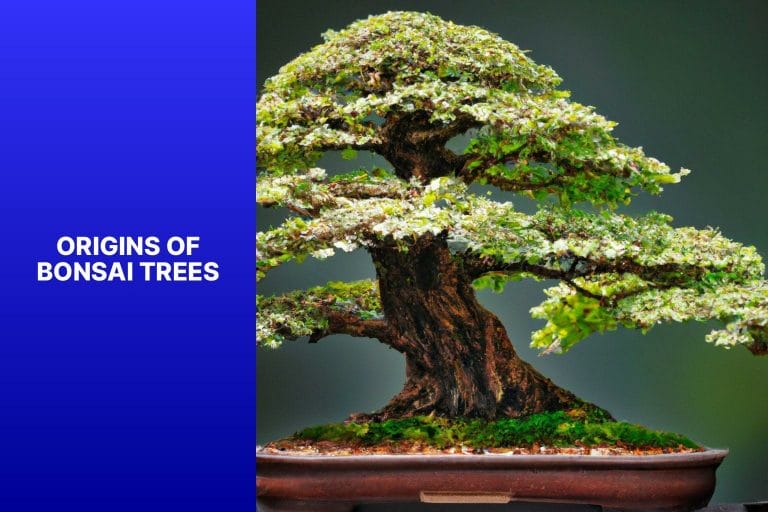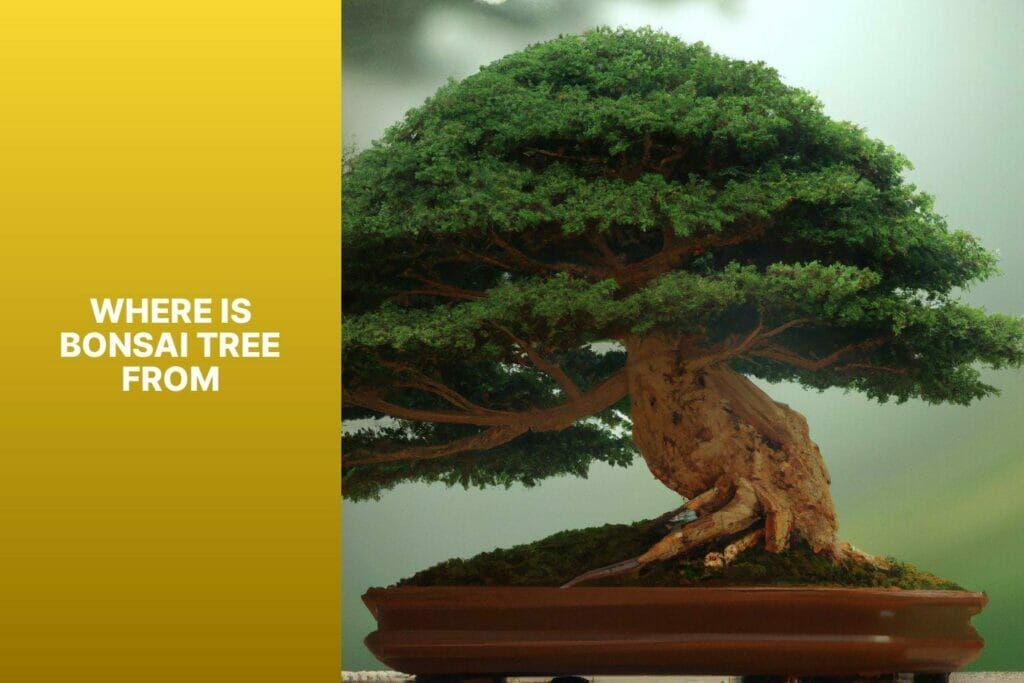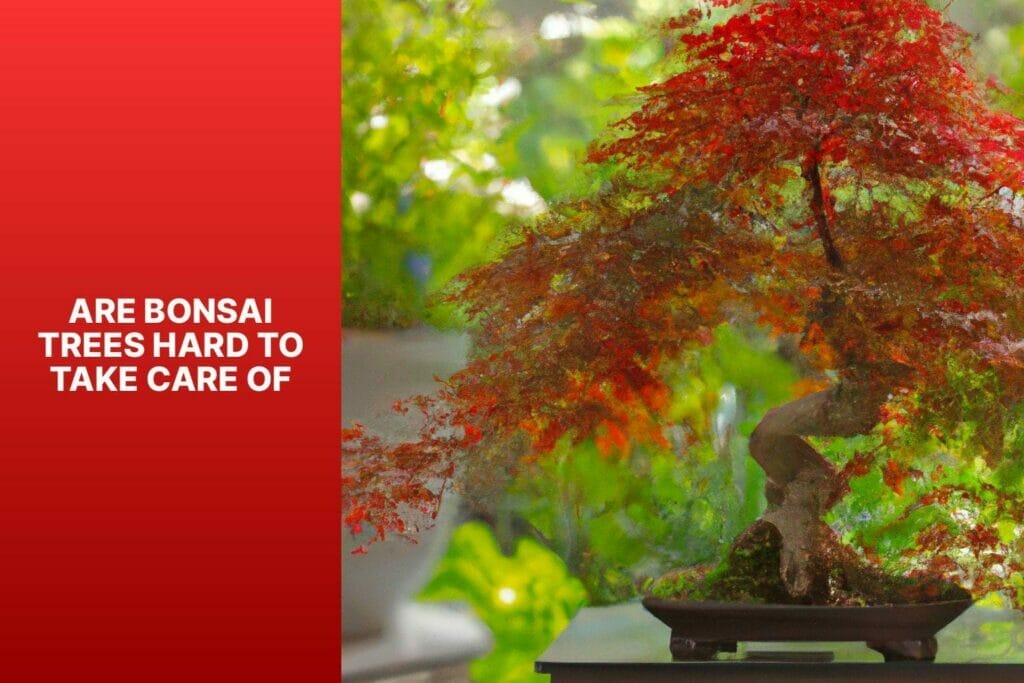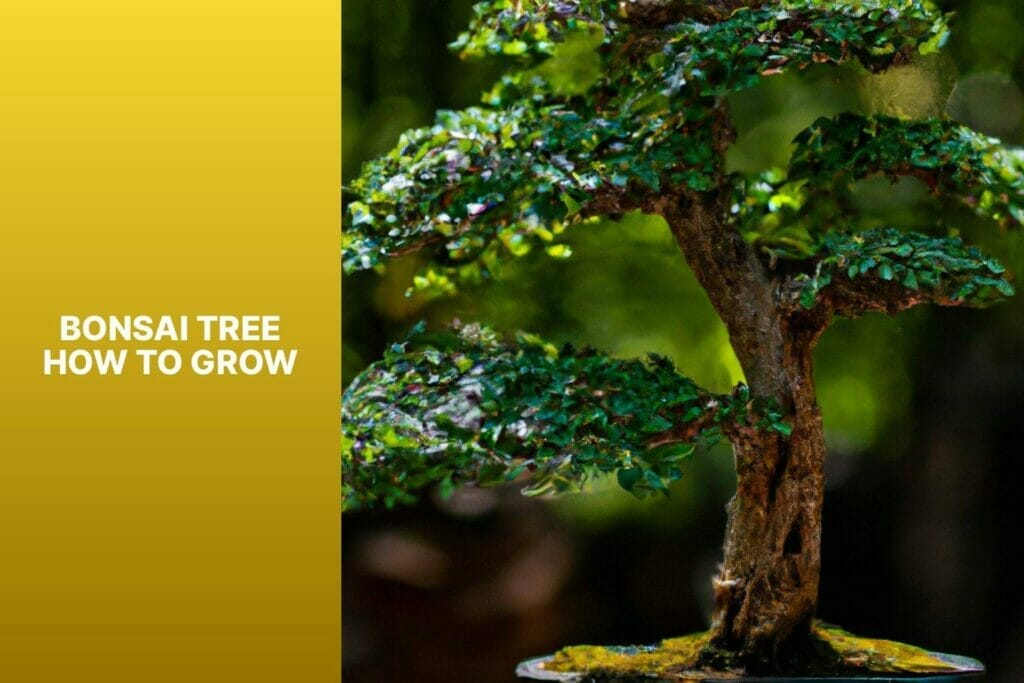Bonsai trees have a rich history and cultural significance, captivating enthusiasts with their beauty and artistry.
It is fascinating to explore the origins of these miniature masterpieces and understand where the bonsai tree comes from.
Bonsai trees have a deep-rooted history that goes back centuries, with their origins traced to several countries worldwide.
1. Historical Background of Bonsai: Bonsai originated in ancient China and Japan, with evidence of its practice dating back thousands of years. It was initially inspired by the ancient Chinese art form of penjing, which focused on creating miniature landscapes. Over time, Bonsai evolved into a distinct and refined art form.
2. Cultural Significance of Bonsai: Bonsai holds great cultural significance in China and Japan. In Chinese culture, Bonsai symbolizes harmony between humans and nature. In Japan, Bonsai represents aesthetic beauty, spiritual contemplation, and a connection to Zen Buddhism.
Bonsai tree cultivation has spread worldwide, with each country putting its unique spin on this art form. Different countries have their traditional bonsai styles and native tree species used for Bonsai.
3. Bonsai Tree Originating Countries: The art of bonsai cultivation originated in China and was later adopted and further developed in Japan. These two countries remain at the forefront of bonsai practices.
4. Traditional Bonsai Styles by Country: Japan is known for its traditional Japanese bonsai style, characterized by simplicity, asymmetry, and naturalistic design. Conversely, China follows the traditional Chinese penjing style, often featuring dramatic landscapes and intricately twisted trunks.
5. Native Tree Species Used for Bonsai in Different Countries: Bonsai enthusiasts in various countries utilize native tree species to create their unique bonsai styles. For example, popular tree species in Japan include pine, maple, and juniper, while China highlights ginkgo, elm, and maple trees.
With the globalization of Bonsai, different varieties, and styles have become popular worldwide, especially among individual traditions and artistic enthusiasts.
By delving into the origins of bonsai trees and understanding the styles and varieties associated with different countries, we can truly appreciate this ancient art form’s global impact and beauty.
Key takeaway:
- Bonsai trees originated from various countries: The bonsai tree has different origins depending on the country. Each country has its traditional bonsai styles and native tree species used for Bonsai.
- Cultural significance of Bonsai: Bonsai trees hold cultural significance in different countries, reflecting their historical background and artistic traditions.
- Bonsai trees have spread worldwide: The art of Bonsai has been introduced to different cultures, leading to the development of global bonsai communities and organizations.
Origins of Bonsai Trees

Photo Credits: Mnbonsainetwork.Com by Daniel Taylor
Bonsai trees have a captivating history that stretches through the ages, revealing fascinating insights into their origins.
Join me as we dive into the historical background of Bonsai, unearthing tales of craftsmanship and dedication. We will also uncover the cultural significance locked within these miniature masterpieces, shedding light on their profound impact on art and spirituality.
Prepare to be amazed by the enchanting world of Bonsai and the stories it holds.
Historical Background of Bonsai
The historical background of Bonsai reveals its cultural significance and the principles guiding its creation.
Cultivating miniature trees in pots, known as Bonsai, originated in ancient China and later spread to Japan.
In ancient China, penjing, or “tray scenery,” involved creating miniature landscapes in pots to evoke a sense of tranquility and harmony with nature.
During Japan’s Kamakura period (1185-1333), Zen Buddhism greatly influenced the development of Bonsai.
Buddhist monks cultivated miniaturized trees in pots to appreciate nature and bring it into their temple gardens.
In the Muromachi period (1336-1573), Bonsai gained popularity among the samurai class for representing harmony, balance, and nature in a confined space.
Over the centuries, Bonsai has evolved and refined, with different techniques and styles developing in different regions of Japan.
Today, Bonsai symbolizes traditional Japanese culture, highly revered for its artistic and spiritual significance.
Understanding the historical background of Bonsai provides insight into its cultural significance and showcases the rich history and heritage of this unique art form, captivating enthusiasts worldwide.
Cultural Significance of Bonsai
Bonsai trees hold immense cultural significance in various societies. They are miniature trees that serve as artistic representations of patience, discipline, and harmony with nature.
The cultural significance of Bonsai lies in its ability to encapsulate the essence of the natural world in a small and controlled form.
In Japanese culture, Bonsai is deeply rooted in Zen Buddhism and is seen as a meditative practice that symbolizes the harmony between humans and nature. Bonsai cultivation requires attention to detail, fostering mindfulness and presence.
In Chinese culture, Bonsai, known as Penjing, is a means of expressing the beauty of nature. It represents the balance between yin and yang and the harmony between humans and their environment.
In South Asian cultures, Bonsai is admired for its aesthetic beauty and artistic expression. It is often associated with principles of balance, simplicity, and tranquility.
In Western cultures, Bonsai has gained popularity as a horticultural art. It is appreciated for its ability to mimic the natural growth patterns of trees in miniature form.
The cultural significance of Bonsai extends beyond its aesthetic appeal. It teaches us patience, discipline, and the value of connecting with nature.
Through cultivating Bonsai, individuals can develop a deeper understanding and appreciation for the beauty and resilience of the natural world.
As you explore the realm of Bonsai, immerse yourself in its rich cultural significance. Take the time to comprehend the traditions and philosophies that have shaped Bonsai throughout history.
Doing so will enrich your experience and forge a deeper connection with the art of Bonsai.
Where is the Bonsai Tree From?
Curious about the origins of the bonsai tree? In this section, we’ll embark on a journey to explore where the bonsai tree comes from.
From the countries where Bonsai originated to the traditional styles in different parts of the world, we’ll uncover fascinating insights.
We’ll discover the native tree species commonly used for Bonsai in various countries. Prepare to delve into the bonsai tree’s rich history and cultural significance!
Bonsai Tree Originating Countries
Bonsai trees originate from Japan, China, Korea, Vietnam, India, Taiwan, Indonesia, Malaysia, Thailand, and the United States.
These countries have unique traditions and practices associated with bonsai cultivation. Each country contributes style and techniques to bonsai art, resulting in diverse tree designs.
Bonsai has a long history and is deeply ingrained in Japanese culture. Japanese bonsai trees are known for their meticulous pruning and shaping techniques, creating natural-looking miniature landscapes.
China also has a strong bonsai tradition. Chinese bonsai trees, called Penjing, aim to capture the essence of nature and often feature gnarled and twisted trunks.
Korea, Vietnam, India, and other Southeast Asian countries have bonsai styles influenced by their cultures and natural landscapes. These styles incorporate native tree species and reflect regional aesthetics.
Bonsai cultivation has recently spread to the United States and other Western countries. Bonsai enthusiasts in these countries have adapted the art form to suit their local climates and tree species.
When starting your bonsai journey, exploring the traditions and techniques of bonsai tree cultivation in these originating countries can be fascinating.
Each country offers a distinct approach to creating and caring for these miniature trees, allowing you to find inspiration and develop your unique bonsai style.
Traditional Bonsai Styles
Each country has unique techniques and aesthetic preferences that contribute to the art form.
In Japan, the traditional style of Bonsai is known as “Misho” or “Yose-ue.” This style creates harmony between the branches and the tree’s overall shape. Asymmetrical arrangements are used to represent the natural growth of trees in Japan.
China has its traditional style called “Penjing.” This style emphasizes the balance between space and living elements. Tranquility and harmony are created through landscapes, rocks, and figurines.
South Asian countries like India and Indonesia also have their distinct bonsai styles. The “Banyan Style” is one such style that involves growing bonsai trees from banyan tree seeds. This style creates trees with complex aerial root networks, symbolizing strength and longevity.
Even Western countries, such as the United States and Europe, have been influenced by the traditional bonsai techniques of Japan and China.
There is also an emphasis on individual creativity and experimentation in these countries. Artists in the West explore styles like formal upright, informal upright, and cascade to express their unique visions.
Studying the traditional bonsai styles from different countries is highly recommended for beginners. This deepens understanding of Bonsai and allows for appreciation of each country’s cultural and artistic nuances to this art form.
As you embark on your bonsai journey, it is important to take inspiration from the traditional styles of different countries. Experiment with various techniques and find a style that resonates with you.
It is also crucial to respect Bonsai’s cultural origins and continue learning and growing in this beautiful art form.
Native Tree Species Used for Bonsai in Different Countries
The native tree species used for Bonsai vary across different countries. Here is a table showing popular tree species used in bonsai cultivation:
| Country | Native Tree Species |
|---|---|
| Japan | Pine, Maple, Juniper |
| China | Elm, Cypress, Chinese Wisteria |
| South Korea | Korean Hornbeam, Pine, Zelkova |
| India | Banyan, Peepal, Mango |
| United States | Juniper, Pine, Maple |
| United Kingdom | Scots Pine, Hornbeam, Oak |
| Brazil | Brazilian Rain Tree, Jacaranda, Jabuticaba |
Pine is commonly used in Japan for Bonsai, while China favors elm and cypress. South Korea prefers Korean Hornbeams and Pine.
In India, bonsai enthusiasts often work with Banyan, Peepal, and Mango trees. The United States commonly uses Juniper, Pine, and Maple, and the United Kingdom favors Scots Pine, Hornbeam, and Oak.
The Brazilian Rain Tree, Jacaranda, and Jabuticaba are frequently used species in Brazil.
It’s important to note that these examples are not exhaustive, as bonsai artists in each country may cultivate other native species. The selection of tree species depends on climate, growth characteristics, and cultural significance.
Bonsai enthusiasts worldwide continue to explore and experiment with different native tree species to create unique and captivating bonsai creations.
Popular Varieties of Bonsai Trees
Discover the captivating world of bonsai trees as we delve into the popular varieties that have captivated enthusiasts worldwide.
From the exquisite traditional Japanese bonsai trees to the intricate Chinese Penjing bonsai trees and the enchanting South Asian and Western variations, each sub-section will unveil the unique characteristics and cultural significance behind these magnificent living art forms.
Get ready to be inspired by the diversity and beauty that the world of Bonsai has to offer.
Traditional Japanese Bonsai Trees
Traditional Japanese Bonsai Trees have a long and rich history, making them a true art form.
These remarkable trees showcase various styles, including the formal upright style (Chokkan), slanting style (Shakan), and cascade style (Kengai), each with its unique characteristics symbolizing different elements of nature.
The choice of tree species is crucial in Traditional Japanese Bonsai Trees, with native species like pine, maple, juniper, and cherry being carefully selected.
These trees possess specific shapes and characteristics perfectly suited for bonsai cultivation.
Pruning and training techniques play a pivotal role in Japanese bonsai cultivation.
Bonsai enthusiasts focus on meticulous methods such as wiring, pinching, and defoliation to maintain the desired shape and form of the tree, thus enhancing its aesthetic appeal.
Reflecting the essence of each season is an essential aspect of Traditional Japanese Bonsai Trees.
Through skillful watering, lighting, and temperature manipulation, these bonsai trees showcase vibrant foliage colors and blooming flowers, mirroring the natural environment in which they thrive.
Beyond their visual beauty, Traditional Japanese Bonsai Trees carry profound symbolic meanings representing harmony, balance, and inner peace. These trees reflect the serene and enchanting qualities found in nature.
A captivating true story highlights bonsai artists’ dedication and passion for preserving this ancient tradition. Mr. Yamada, a renowned bonsai master, devoted decades to cultivating a small juniper tree that eventually transformed into a breathtaking masterpiece.
His unwavering attention to detail and steadfast commitment to the art form resulted in a Traditional Japanese Bonsai Tree that represents the true essence of a mature tree.
This masterpiece is a testament to Mr. Yamada’s exceptional skill and the undeniable beauty of Traditional Japanese Bonsai Trees.
Chinese Penjing Bonsai Trees
Chinese Penjing Bonsai Trees originated in China and have a rich cultural history. They are known for their intricate designs and attention to detail.
These bonsai trees mimic natural landscapes like mountains, forests, and rivers. Miniature figurines, buildings, and animals are often added to create harmony and balance.
Various techniques, such as pruning, wiring, and shaping the branches and foliage, create stunning visual effects. The goal is to create a miniaturized version of nature that is aesthetically pleasing and representative of the natural world.
Chinese Penjing Bonsai Trees evoke tranquility and serenity. They are popular worldwide, with enthusiasts and collectors appreciating the skill and artistry involved in their creation.
When caring for Chinese Penjing Bonsai Trees, it is important to understand the specific needs of each tree species.
Proper sunlight, watering, and pruning techniques are essential for maintaining health and beauty. Regularly checking for pests and diseases is also necessary.
Consult with experts or reputable resources for guidance on the specific care requirements of Chinese Penjing Bonsai Trees.
South Asian Bonsai Trees
South Asian bonsai trees, like the Ficus religiosa (Sacred Fig tree) and the Ficus benjamina (Weeping Fig tree), are a unique addition to the world of Bonsai.
These trees showcase the cultural heritage of India, Sri Lanka, and Bangladesh. Traditional techniques such as root over rock style and forest planting are used to shape these trees carefully in the art of bonsai cultivation.
Every detail, from the trunk shape to the leaf size, is paid attention to. Globally, South Asian bonsai trees have gained popularity as they symbolize cultural diversity and artistic expression.
For bonsai enthusiasts, these trees offer an enchanting experience, as they showcase the beauty of nature in miniature form.
Western Bonsai Trees
Western bonsai trees have gained popularity recently due to their unique style and cultural significance. They originated in Western countries like the United States and Europe and differed from traditional Japanese or Chinese Bonsai styles and techniques.
Western Bonsai Trees aim to create a natural and wild appearance, imitating forests or landscapes. This style emphasizes using native tree species to capture the essence of the Western natural environment.
Popular Western bonsai tree varieties include Juniper, Pine, Oak, and Maple.
Unlike traditional bonsai trees, Western bonsai enthusiasts take a more experimental approach, allowing for artistic freedom and personal expression. This has resulted in the cultivation of unique and innovative bonsai designs.
Western bonsai communities and organizations have grown recently, fostering community and providing platforms for bonsai enthusiasts to share ideas and techniques.
They hold workshops, exhibitions, and competitions to showcase the beauty and artistry of Western bonsai trees.
How Bonsai Trees Have Spread Worldwide
Bonsai trees have taken root across the globe, shaping different cultures and growing vibrant communities. From their origins in East Asia to finding their way into the hearts and homes of people worldwide, the spread of Bonsai is a testament to its universal appeal.
In this section, we’ll explore how Bonsai has captivated diverse cultures, delving into its introduction to different parts of the world and the flourishing global communities and organizations dedicated to this ancient art form.
Introduction to Bonsai to Different Cultures
Bonsai trees have captivated enthusiasts worldwide with their unique beauty and artistry. This article explores how different cultures have embraced the ancient art form of Bonsai.
1. Bonsai in Japan: Japan has a deep-rooted bonsai tradition known as “Bonkei,” which has been celebrated for centuries. Japanese bonsai styles like Chokkan and Moyogi showcase the country’s aesthetic principles and attention to detail.
2. Bonsai in China: China has a rich history of bonsai craftsmanship called “Penjing.” Chinese bonsai styles emphasize natural landscapes and asymmetry, reflecting the deep connection between humans and nature. Penjing has greatly influenced bonsai development globally.
3. Bonsai in South Asia: Bonsai has been embraced by countries like India and Indonesia, which have incorporated their cultural and artistic influences into the art form. These countries have created distinctive and visually stunning bonsai specimens.
4. Bonsai in the West: Western countries have enthusiastically embraced Bonsai as an art form and symbol of patience, discipline, and serenity. Western bonsai artists have developed their styles, adapting traditional techniques to create innovative and contemporary bonsai designs.
As bonsai trees have spread worldwide, they have become symbols of cultural exchange and appreciation for the beauty of nature.
Global bonsai communities and organizations have emerged, allowing enthusiasts from different cultures to connect, learn, and share their passion for this ancient art form.
Introducing Bonsai to different cultures has fostered unity and mutual appreciation for the artistry and tranquility of these miniature masterpieces.
Global Bonsai Communities and Organizations
Global Bonsai Communities and Organizations promote and preserve the art of Bonsai worldwide. These groups provide platforms for bonsai enthusiasts to connect, learn, and share their knowledge and experiences.
For more information on the history of bonsai trees, visit Where is bonsai tree from.
– International Bonsai Clubs: Numerous international bonsai clubs bring together bonsai lovers from different countries. These clubs organize workshops, exhibitions, and competitions to enhance the skills and knowledge of enthusiasts.
– World Bonsai Friendship Federation (WBFF): WBFF is a global organization that promotes Bonsai as a cultural and artistic form. They organize international bonsai conventions, facilitate cultural exchanges, and provide educational resources.
– Online Forums and Communities: The internet allows bonsai enthusiasts worldwide to connect and share their passion. Online forums and communities provide a platform for discussing techniques, sharing photos, and seeking advice from experienced bonsai practitioners.
– Bonsai Exhibitions and Conferences: Various bonsai exhibitions and conferences take place globally, bringing together bonsai artists, collectors, and enthusiasts. These events allow one to admire stunning bonsai displays and learn from renowned masters.
– Bonsai Publications and Journals: Several publications and journals focus on Bonsai, offering valuable insights, techniques, and inspiration. These resources contribute to the dissemination of knowledge and the growth of the bonsai community.
If you want to join the global bonsai community, consider joining local bonsai clubs, participating in online forums, attending exhibitions and conferences, and staying updated with bonsai publications.
Engaging with these communities and organizations will allow you to learn, share, and connect with fellow bonsai enthusiasts worldwide.
Some Facts About Where Bonsai Trees Are From:
- ✅ Bonsai trees originated in China over 1,000 years ago. (Source: Britannica)
- ✅ Bonsai was introduced to Japan during the Kamakura period. (Source: Our Team)
- ✅ Bonsai trees are mainly developed and cultivated by the Japanese. (Source: Our Team)
- ✅ Bonsai trees are inspired by natural trees that grow in rocky crevices or overhang cliffs. (Source: Britannica)
- ✅ Bonsai trees have a rich history in Japan and have become a beloved art form worldwide. (Source: Bonsai Empire)


